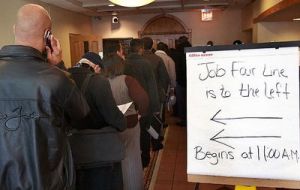MercoPress. South Atlantic News Agency
US jobless rate in June 9.5%; 14.7 million unemployed
 Since the start of recession in December 2007, 7.2 million jobs have been lost.
Since the start of recession in December 2007, 7.2 million jobs have been lost. The number of jobs lost in the US last month came in at 467,000, which was much more than had been expected. The jobless rate rose to 9.5% in June, from 9.4% in May, as the US economy continued to struggle.
Since the start of the recession in December 2007, the number of jobless people has risen by 7.2 million, the Department of Labour said in a Thursday release.
The unemployment rate was slightly lower than had been expected, but was still the highest since August 1983.
The number of people losing their jobs can be higher than expected at the same time as the jobless rate is lower than expected, because they are measured in different ways.
The former is a measure of how many people are working, while the latter shows the number of people looking for work.
Not everybody who has lost a job will be looking for another one.
President Barack Obama said he was “deeply concerned” about the high level of unemployment and said more needed to be done to create jobs.
“We have successfully stabilised the financial markets,” and “started to see some stabilization on housing,” he told the Associated Press.
“But what we are still seeing is too many jobs lost,” he added.
The non-farm payrolls number would usually be released on a Friday, but has been announced a day early because US markets will be closed on Friday.
The latest set of figures also included revisions to data for the two previous months, with the number of jobs lost in April rising 15,000 to 519,000 and the number lost in May falling 23,000 to 322,000. Average hourly earnings were unchanged at 18.53 US dollars. A total of 14.7 million people were unemployed in June, the figures showed.
The job losses come despite recent signs of optimism from surveys.
In its separate weekly jobs report, the Department of Labour said that the number of newly laid-off workers applying for employment benefits last week fell to 614,000, while the number of people continuing to claim benefits unexpectedly fell to 6.7 million.
The average working week for production and non-supervisory workers fell 0.1 hour to 33.0 hours, which was the lowest since records began in 1964, suggesting that more people are working part-time.
The average working week for manufacturers rose 0.1 hour to 39.5 hours. (BBC).-




Top Comments
Disclaimer & comment rules-

Read all commentsHmm, the Obama said it would never get over 8... What and where is all that stimulus money, and exactly who is it stimulating?
Jul 05th, 2009 - 10:53 am 0Commenting for this story is now closed.
If you have a Facebook account, become a fan and comment on our Facebook Page!